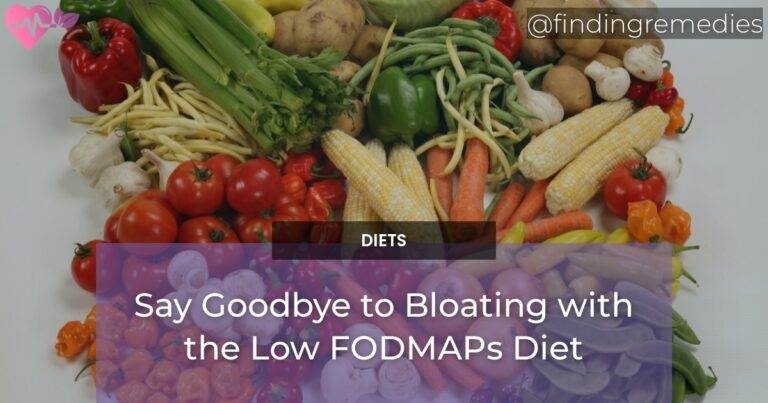Are you tired of feeling bloated, experiencing gas, abdominal pain, diarrhea, and constipation? These symptoms may be a sign of food sensitivities or Irritable Bowel Syndrome (IBS). Fortunately, the Low FODMAPs Diet can help alleviate these symptoms and improve your overall digestive health.
This comprehensive guide will provide you with all the necessary information to understand and implement the Low FODMAPs Diet.
Table of Contents
What is the Low FODMAPs Diet?
The Low FODMAPs Diet is a specialized diet that eliminates foods that are high in FODMAPs (Fermentable Oligosaccharides, Disaccharides, Monosaccharides, and Polyols), which are carbohydrates that are poorly absorbed by the small intestine. When these carbohydrates reach the large intestine, they ferment and produce gas, leading to symptoms such as bloating, gas, and abdominal pain. The Low FODMAPs Diet has been shown to be effective in reducing these symptoms and improving overall digestive health.
Key Components of the Low FODMAPs Diet
The Low FODMAPs Diet involves two phases:
- Elimination Phase: This phase involves eliminating foods that are high in FODMAPs for a period of 2-6 weeks. This allows your gut to heal and your symptoms to improve.
- Reintroduction Phase: This phase involves reintroducing high FODMAP foods one at a time to determine which foods trigger your symptoms. This helps you identify your specific trigger foods, so you can avoid them in the future.
List of Foods to Avoid
During the Elimination Phase, you should avoid the following high FODMAP foods:
- Fructose (found in honey, apples, pears, mangoes, and agave nectar)
- Lactose (found in milk, ice cream, and soft cheeses)
- Fructans (found in wheat, onions, garlic, and some fruits and vegetables)
- Galactans (found in beans, lentils, and soybeans)
- Polyols (found in some fruits and vegetables, and sugar-free gum and candy)
List of Foods to Consume
The following low FODMAP foods are safe to consume:
- Meat, poultry, fish, and seafood
- Eggs
- Lactose-free dairy products
- Gluten-free grains (such as rice, quinoa, and corn)
- Fruits (such as bananas, grapes, oranges, and strawberries)
- Vegetables (such as carrots, cucumber, lettuce, tomatoes, and zucchini)
Meal Planning and Preparation
Planning and preparation are essential when following the Low FODMAPs Diet. Here are some tips to help you plan and prepare your meals:
- Create a meal plan for the week to ensure you have all the necessary ingredients and avoid last-minute temptations.
- Prepare your meals in advance to save time and ensure you have healthy options readily available.
- Read food labels carefully to avoid hidden sources of FODMAPs.
ALSO READ
Health Benefits of the Low FODMAPs Diet
The Low FODMAPs Diet has been shown to have several health benefits:
Improved Digestive Health
Eliminating high FODMAP foods can reduce gut inflammation and improve the balance of your gut bacteria, promoting better digestive health.
Reduced Symptoms of Irritable Bowel Syndrome (IBS)
The Low FODMAPs Diet has been shown to be effective in reducing the symptoms of IBS, including bloating, gas, abdominal pain, diarrhea, and constipation.
Weight Management
The Low FODMAPs Diet can help with weight management, as it emphasizes whole, unprocessed foods that are naturally low in calories and high in nutrients.
Scientific Evidence Supporting the Low FODMAPs Diet
Several clinical studies and research findings have supported the effectiveness of the Low FODMAPs Diet in reducing symptoms of IBS and improving digestive health. Here are some expert opinions and recommendations:
- The American College of Gastroenterology recommends the Low FODMAPs Diet as a first-line dietary intervention for the management of IBS.
- A review of 22 clinical studies found that the Low FODMAPs Diet was effective in reducing IBS symptoms in 50-80% of patients.
ALSO READ
Tips for Success on the Low FODMAPs Diet
Here are some tips to help you succeed on the Low FODMAPs Diet:
Working with a Registered Dietitian
A Registered Dietitian can provide you with personalized guidance and support to help you implement the Low FODMAPs Diet.
Keeping a Food Diary
Keeping a food diary can help you keep track of what you eat and identify any trigger foods that may be causing your symptoms.
Managing Stress and Lifestyle Factors
Stress and lifestyle factors can also impact your symptoms. Incorporating stress-reducing activities, such as exercise and meditation, can help improve your digestive health.
Risks and Precautions Associated with the Low FODMAPs Diet
While the Low FODMAPs Diet is generally safe, there are some risks and precautions to be aware of:
Nutrient Deficiencies and Imbalances
Eliminating certain foods from your diet can increase your risk of nutrient deficiencies and imbalances. Working with a Registered Dietitian can help you ensure you are getting all the necessary nutrients.
Potential Negative Effects on Gut Microbiota
The Low FODMAPs Diet can have a negative impact on the diversity and abundance of your gut microbiota. Reintroducing high FODMAP foods during the reintroduction phase can help restore your gut microbiota.
Limited Long-Term Evidence
There is limited long-term evidence on the safety and effectiveness of the Low FODMAPs Diet. If you are experiencing severe symptoms or long-term digestive issues, you should consult with a healthcare professional before starting the Low FODMAPs Diet.
Conclusion
The Low FODMAPs Diet can be an effective way to alleviate symptoms of IBS and improve your digestive health. By following the key components of the Low FODMAPs Diet, you can enjoy a healthy, nutrient-dense diet without experiencing uncomfortable symptoms. Work with a Registered Dietitian and incorporate stress-reducing activities to ensure your success on the Low FODMAPs Diet.
RELATED ARTICLES:

